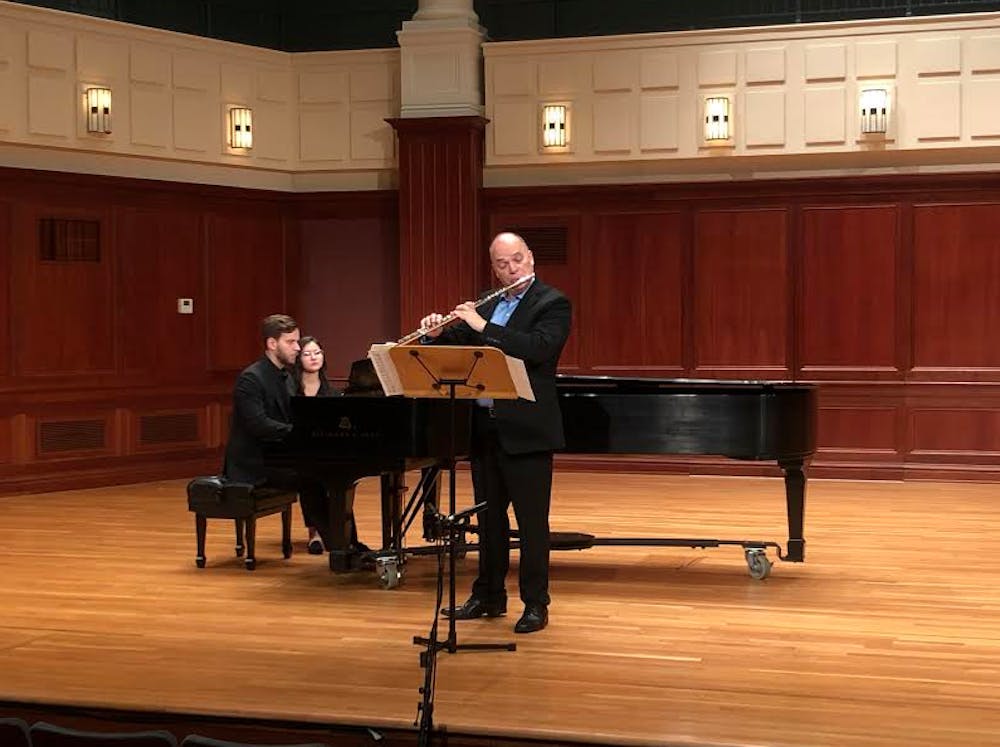By Jennifer Somers
Photo Editor

Fluttery and crisp melodies sounded like birds chirping through Mayo Concert Hall on Sunday, Sept. 29 at David DiGiacobbe’s Music Faculty Recital.
DiGiacobbe, adjunct professor of music, performed with the flute, while pianist Vladimir Rumyantseve accompanied him.
Rumyantseve has been a featured artist at Weill Recital Hall at Carnegie Hall, Steinway Hall, the German consulate, Le Poisson Rouge and The Frick Museum. Currently he teaches at several prestigious preparatory schools in New York City and is an active soloist and collaborative pianist in the surrounding area.
DiGiacobbe and Rumyansteve performed “Sonata in G Major BWV 525” with three movements — Allegro moderato, Adagio and Allegro by JohannSebastian Bach. The combination of flute and piano truly complimented one another, as the piece was magical and energetic with some eerie tones in certain parts.
They then performed “Sonatine” by Henri Dutilleux and “Duo for flute and piano” by Aaron Copland. After each piece, the audience was in complete awe. Murmurs could be heard from the crowd saying how beautiful and brilliant each song was.
“I feel strongly about all music reflecting emotions,” DiGiacobbe said.
His passion radiated throughout his entire performance as he let the music flow throughout his body like he was sitting on a wave and letting it move him to and fro. His facial expressions also enunciated each note.
The first song after intermission was “Poison Mushroom,” which was written by Dai Fujikura in 1977.
“This next piece is about World War II, when the atomic bomb hit Hiroshima. Dai Fujikura was raised outside of the town. Growing up, he had to visit the memorials,” DiGiacobbe said.
The piece had a distinct score, as the flute was accompanied by electronic sounds provided by Hunter Green, one of DiGiacobbe’s students. There were sounds of aircrafts, screams of horror and natural surroundings. It captured history in every essence in just nine minutes.
“He couldn’t believe the beauty of it all now compared to the disaster that it once was years ago. This piece is a reflection of him watching the videos of destruction on Hiroshima,” DiGiacobbe said.
DiGiacobbe and Rumyantseve then performed “En Bateau” by Claude Debussy. The flute and piano never overshadowed after each piece, as they bounced back-and-forth while the audience basked in each note.
They performed their last piece, “Sonata in A major,” with four movements — allegro ben moderato, allegro and ben moderato, Recitativo-Fantasia, and Allegretto poco mosso by Cesar Franck. When he played his final note, he got a standing ovation from the audience. Even after a two-hour recital, the audience still wanted an encore. When DiGiacobbe walked off stage, the crowd was still applauding and cheering for him.
As they left the show, audience members waited in the lobby for DiGiacobbe, who was still receiving applause to their fullest abilities.
Nick Napier, a senior music education major, was very inspired by the performance DiGiacobbe gave. As a music education major, Napier also got an idea of how he should be playing his instruments through technique and style.
“I just recently started taking woodland classes, learning new instruments,” Napier said. “I found myself through the performance studying his posture, distance from his flute, embouchure (the way in which a player shapes their lips to the mouthpiece of the instrument). It provided a good outlook for studying instruments that aren’t my own.”







